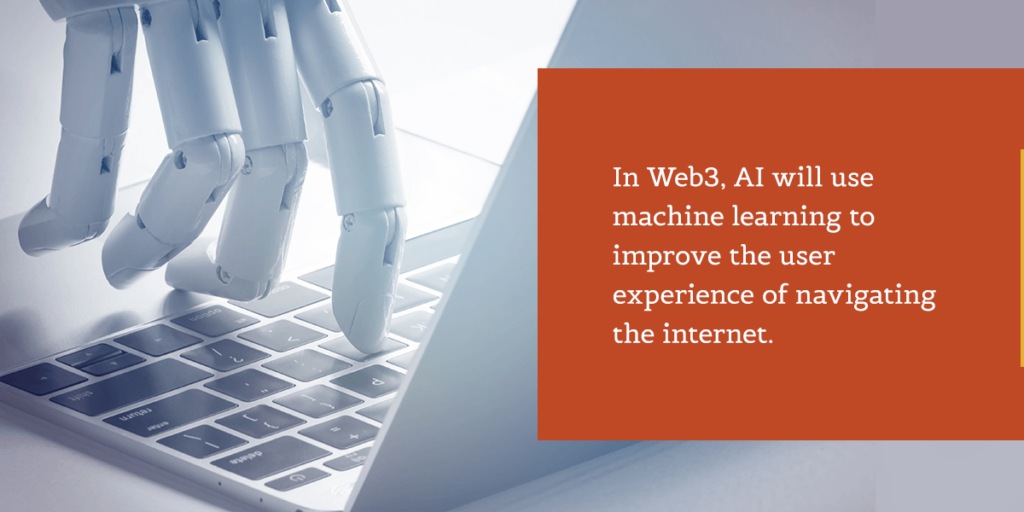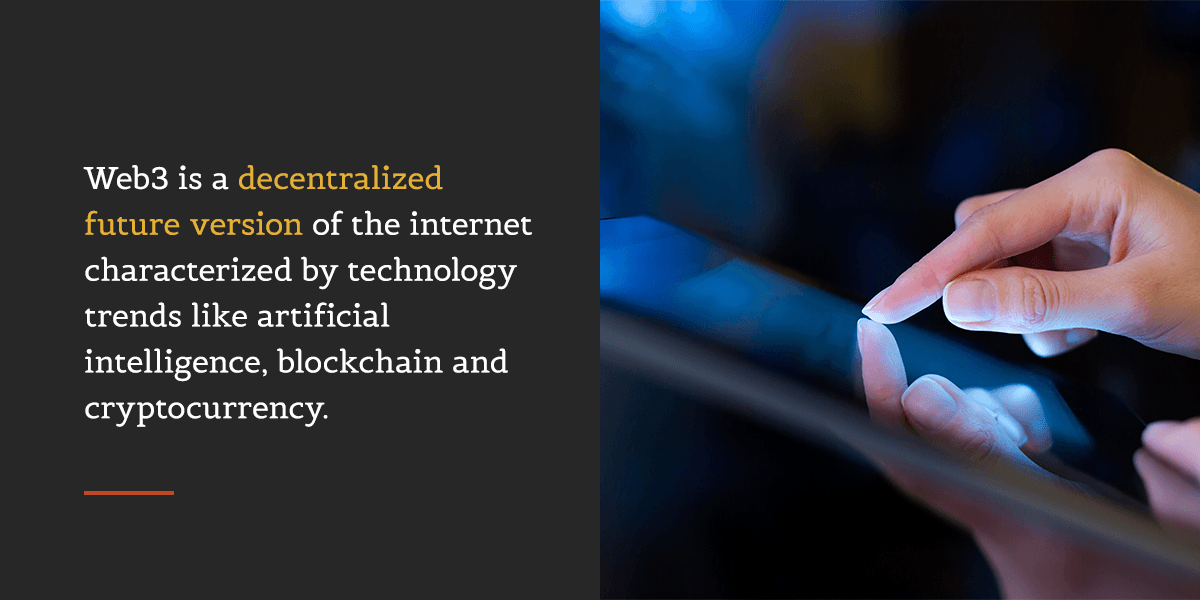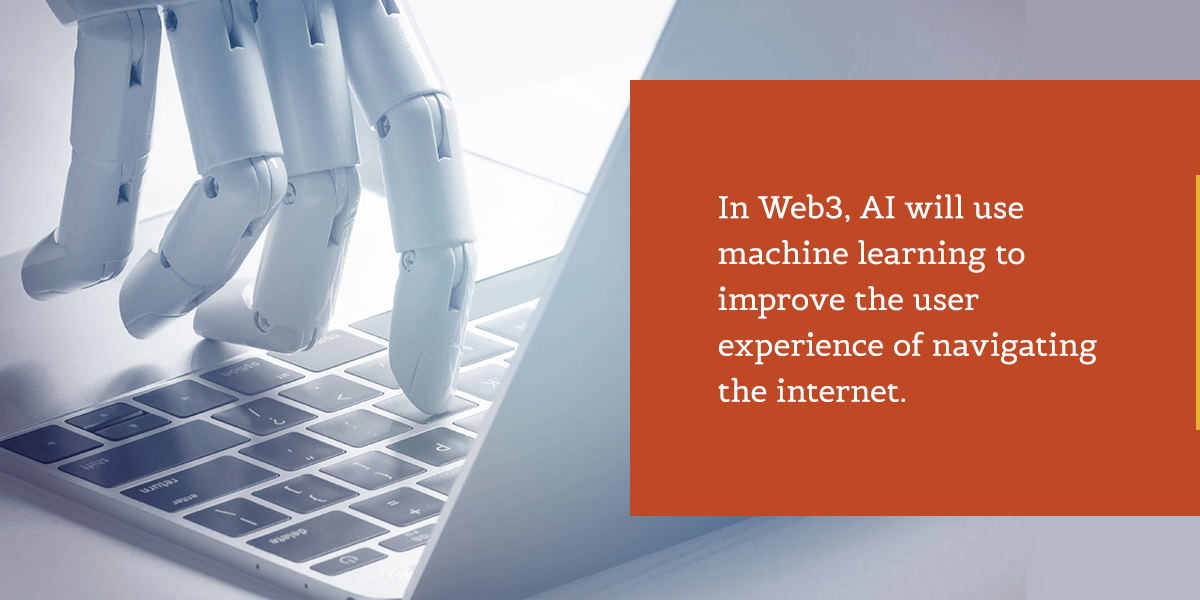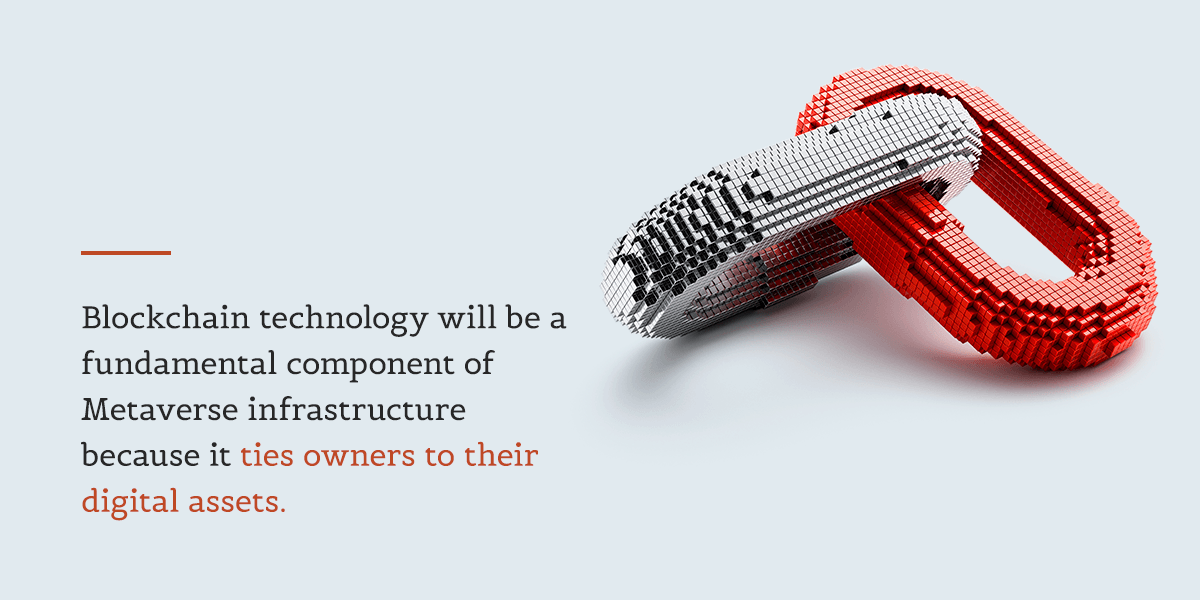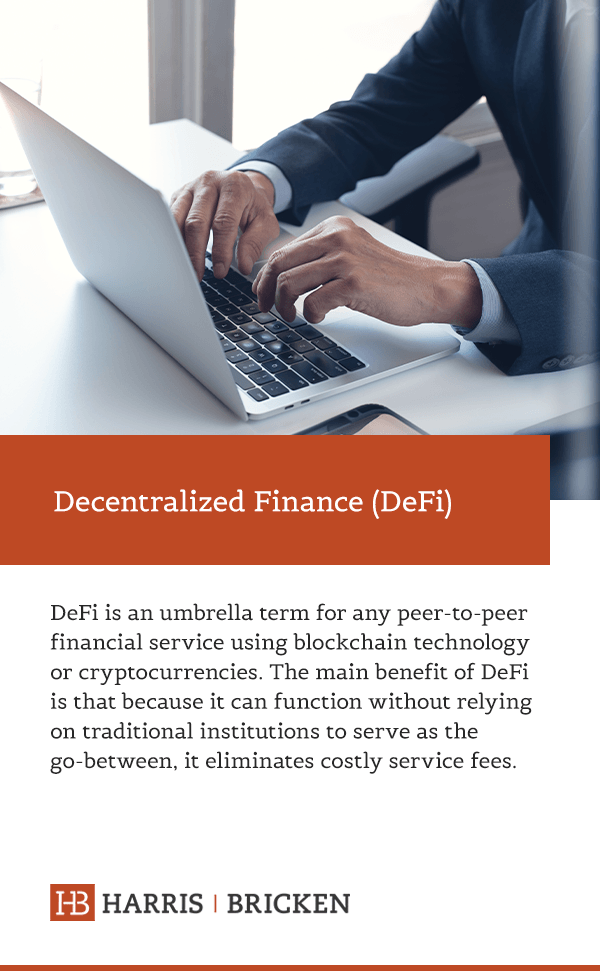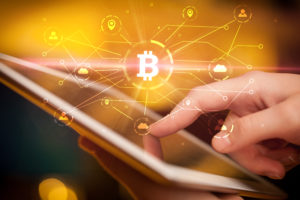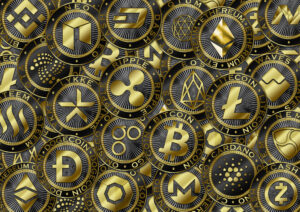Today’s internet looks radically different from the static HTML pages of the 1990s, and it’s still evolving. New words like “Metaverse” and “Bitcoin” are now mainstream, and many speculate a new digital revolution is underway.
Enter Web 3.0.
What Is Web3?
Web3 is a decentralized future version of the internet characterized by technology trends like artificial intelligence, blockchain, and cryptocurrency. Although it’s still in its nascent phase, tech experts have created various theories about what it will look like when fully deployed.
Here’s a quick breakdown of how we got here:
- Web1: The first iteration of the internet was primarily a means of democratizing information. It featured static read-only web pages with few interactive elements, if any. Web1 lasted until about the mid-2000s, when social media first began gaining popularity, fostering massive adoption of the internet.
- Web2: Most of the websites and applications we use today are part of Web2. The explosion of user-driven platforms such as YouTube, Facebook, Twitter, and the like ushered in the age of influencers and the sharing economy. One key theme of Web2 is that users do not own or have the ability to easily monetize their data.
- Web3: The web’s theoretical future, which marks its start from Satoshi’s Bitcoin whitepaper and the launch of Bitcoin in 2009. Web3’s defining features include decentralized infrastructure, open source technologies, anonymization, and expansion of the Internet of Things (IoT). Some believe this version of the internet will give individual users greater ownership and autonomy over their online activity.
Because the internet is decentralized, governments are experiencing major obstacles in regulating it. For example, it’s difficult to determine who has jurisdiction over a network when there’s no centralized authority and nations have different incentives for participating.
Why Is Web3 Important?
Although much of Web3 is still largely in development or the subject of speculation, understanding the basics of the decentralized internet will be essential for companies if they want to survive the shift into Web3.
Just like with Web2, organizations that successfully figure out how to get into Web3 ahead of the competition can anticipate market prominence as early adopters.
Web3 Terms: What You Need to Know
Getting familiar with Web3 terminology will make navigating the internet’s evolution much easier.
Altcoin
Any cryptocurrency other than Bitcoin is an altcoin. According to data from CoinMarketCap, the leading crypto price tracker, there are more than 20,000 altcoins in the marketplace.
As of this writing, Ethereum (ETH) is the most popular altcoin, followed by BNB, XRP, Cardano, and DOGE, along with stablecoins like Tether (USDT), USD Coin (USDC), Binance USD, DAI, and TUSD.
See also: Bitcoin, Cryptocurrency, Ethereum
Artificial Intelligence (AI)
Artificial intelligence refers to a machine’s ability to perform tasks that, until this point, only humans could do. Many AI use machine learning (ML), which is an AI technique that enables computer programs to learn from past data without human intervention.
Some examples of AI in use today include:
- Voice assistants
- AI chatbots (ChatGPT)
- Text editors
- Social media algorithms
- Fraud detection
In Web3, AI will use machine learning to improve the user experience of navigating the internet. For example, AI algorithms already provide personalized search recommendations based on user data. Proponents of AI say it will improve access to accurate information, which will be essential in the age of DeFi.
See also: Decentralized Applications, Decentralized Finance, Smart Contracts
Augmented Reality (AR)
AR is a Web3 technology that has become increasingly popular in recent years. It works by adding digital elements to the user’s real-world environment, enhancing their existing reality rather than placing them in a completely virtual world.
Snapchat’s AR camera filters are a great example of AR in action. When you activate one of the filters, the app applies an overlay that adds virtual elements to the image. This overlay can be as simple as adding freckles to your face or as complicated as generating a cartoon version of yourself.
The biggest draw of AR is its minimal hardware requirement — all you need is a camera and the right software to get started. Along with virtual reality and blockchain technology, AR will be a core part of the Metaverse infrastructure.
See also: Metaverse, Virtual Reality
Bitcoin (BTC)
The original cryptocurrency, Bitcoin is the most popular digital currency in use today. Although tech experts had theorized about cryptocurrencies before 2008, Satoshi Nakamoto’s white paper solved the issue of double spending (cutting and pasting code to create more currency), which was the primary obstacle for cryptocurrency implementation and adoption.
Bitcoin mining is one of the most energy-intensive computer processes in the world. The systems that maintain the network and create new tokens use enough electricity to power entire countries. Mitigating its environmental impact will be a major concern moving forward, which is one reason why Ethereum moved from proof of work to proof of stake in its network in September 2022.
See also: Altcoin, Cryptocurrency, Ethereum
Blockchain
A blockchain is a chain of permanent information blocks on a digitally distributed online ledger. Blockchains are decentralized, meaning the information they contain exists on a network of computers rather than a single device.
These blocks contain individual packets of data about assets and transactions. Once one block reaches capacity, another forms and links to it using cryptography, creating a digital chain.
The benefit of blockchain technology is its immutable nature — once a block fills up, you can’t go back and change anything in it without controlling a majority of the computers running the network. This makes it a secure way to record online transactions.
Businesses can use blockchain networks to track a seemingly endless variety of data points, including:
- Orders
- Payments
- Production
- Crypto transactions
- Asset ownership
- Accounts
For example, if a user buys digital real estate in the Metaverse, the blockchain record will show that it belongs to them.
See also: Cryptocurrency, Cryptography, Decentralized Finance, Ethereum, Metaverse, Smart Contracts
Coin
This is a unit of any cryptocurrency existing on its own blockchain. While coins and tokens are similar in the crypto sphere and are often used interchangeably, coins have fewer uses. You can only use crypto coins as a form of payment or as an investment asset unless the code controlling the coins provides additional functionality.
See also: Cryptocurrency, Cryptography, Initial Coin Offering, Non-Fungible Tokens
Cryptocurrency
Cryptocurrency, or crypto, refers to any digital currency that uses cryptography to make transactions on a blockchain. The most popular cryptocurrencies use blockchains to make a record of transactions rather than just facilitate currency transfers.
There are several ways users can get crypto, including:
- Mining: Digital currency mining creates new crypto tokens for the marketplace. The process works differently across cryptocurrencies and blockchains.
- Staking: This occurs when cryptocurrency holders lend their cryptocurrency to a blockchain or exchange to facilitate transactions, for which they are rewarded additional cryptocurrency.
- Crypto exchanges: These are platforms for buying, selling, and trading cryptocurrencies. It’s important to find an exchange that aligns with your goals because each exchange offers different coins and investment tools, with varying levels of compliance.
- Cashback rewards programs: Crypto cashback rewards enable you to receive a portion of your purchases back in crypto tokens. Some popular ways to get crypto cashback include participating coin exchanges, credit cards, P2E (play to earn) games, and browser extensions.
See also: Altcoin, Bitcoin, Blockchain, Coin, Cryptography, Decentralized Finance, Ethereum, Non-Fungible Tokens
Cryptography
Cryptography is a field of study and a technique of securing communications using algorithmic ciphers so that only the sender and intended recipients can view the contents. Encryption algorithms such as AES and DES are some of the most secure methods of cryptography in use today.
Cryptography is central to blockchain infrastructure because it secures transactions in the otherwise open peer-to-peer blockchain network.
See also: Blockchain, Cryptocurrency
Decentralized Applications (dApps)
A dApp is a peer-to-peer application running on a blockchain. dApps usually use smart contracts to access the blockchain network and enforce the terms of agreement.
dApps can serve any purpose, from entertainment to financial services. Some notable examples include:
- Audius: A music streaming dApp that allows artists to create NFTs of their music on the blockchain. When users stream their tracks, artists receive the app’s native token (AUDIO) as payment.
- Steemit: A blockchain-based social media dApp that allows users to create, post, and interact with content for digital rewards.
- Uniswap: The most popular decentralized crypto exchange on the Ethereum blockchain. Many other exchanges, such as Pancake Swap, use Uniswap’s source code on other blockchains.
See also: Artificial Intelligence, Decentralized Finance, Ethereum, Smart Contracts, Token
Decentralized Autonomous Organizations (DAOs)
Sometimes called a Decentralized Autonomous Cooperative (DAC), a DAO is a member-run organization formed to fulfill a specific function. As the name implies, a DAO operates without a central authority. Instead, DAOs rely on smart contracts to:
- Outline foundational rules
- Vote
- Execute agreed-upon decisions
DAO members receive governance tokens they can use to vote on important decisions, such as funding allocations and technical upgrades.
One of the most famous examples is ConstitutionDAO, which collectively raised $47 million in an attempt to purchase an original copy of the U.S. Constitution from a Sotheby’s auction. Although the group lost the bid in the end, Sotheby’s would have allowed them to buy the document using a blockchain transfer.
As of April 2023, the states that recognize DAOs as legal entities are Vermont, Tennessee, Wyoming, and Utah. The legal status is still undecided in most other states, though some DAOs have successfully registered as LLCs in Delaware.
See also: Decentralized Finance, Smart Contracts
Decentralized Finance (DeFi)
DeFi is an umbrella term for any peer-to-peer financial service using blockchain technology or cryptocurrencies. The main benefit of DeFi is that because it can function without relying on traditional institutions to serve as the go-between, it eliminates costly service fees and streamlines cross-border payments.
See also: Artificial Intelligence, Blockchain, Cryptocurrency, Decentralized Applications, Decentralized Autonomous Organization
Ethereum (ETH)
Ethereum is the name of the blockchain for Ether (ETH), the second biggest cryptocurrency after Bitcoin. Unlike Bitcoin, which is primarily intended for use as a digital currency, the Ethereum platform can support complex functions like smart contracts and dApps as layer-2 protocol built on top of Ethereum.
Its ability to support smart contracts gives it more functionality than the Bitcoin blockchain, which is why it is so prominent in Web3.
See also: Altcoin, Bitcoin, Blockchain, Cryptocurrency, Decentralized Applications, Smart Contracts
Initial Coin Offering (ICO)
An ICO is the digital version of an initial public offering (IPO), where a private company or venture offers equity or debt to the public for the first time. Similarly, companies can raise funds for projects by selling cryptocurrency tokens to investors in an ICO.
Those tokens can either represent a stake in the venture or provide a utility related to the venture’s offerings. Fraud has been a major legal concern with ICOs due to their mostly unregulated operations and ease of engaging in an ICO across the world simultaneously.
See also: Coin, Token
Metaverse
The Metaverse, in its simplest explanation, is a virtual world that operates on a digital economy. Although big tech companies like Meta and Microsoft are investing large sums into Metaverse technology, it’s still in the early phases of development.
While it is possible that the Metaverse could refer to one unified virtual world, it’s just as likely that there will be multiple independent Metaverses, each belonging to a specific company. Each Metaverse would serve a specific purpose, similar to how each social media platform offers different features.
Whatever its final form will be, the Metaverse will rely on blockchain technology for property rights, like digital collectibility and proof of ownership as well as transfer of value.
See also: Augmented Reality, Blockchain, Non-Fungible Tokens, Virtual Reality
Non-Fungible Tokens (NFTs)
An NFT is a unique cryptographic token that links to a blockchain. Most NFTs exist on the Ethereum blockchain, though they can also occupy others. Sellers often use NFTs to sell digital assets, such as:
- Collectibles
- Digital art
- Virtual real estate
Typically, an NFT sale doesn’t involve the transfer of intellectual property. This is because the NFT is not the image or collectible — it’s the token on the blockchain that represents it and provides certain rights relating to the underlying asset. So while the original creator of the representation often retains ownership of their work, the buyer owns the link to a digital copy.
Although they are both types of blockchain tokens, the key difference between an NFT and a cryptocurrency or coin is that cryptocurrencies are interchangeable, or fungible. NFTs are non-fungible, meaning they are not interchangeable even though they may look the same.
See also: Coin, Cryptocurrency, Metaverse, Token
Smart Contracts
A smart contract is a blockchain protocol that automatically executes predefined processes when specific conditions are met. For example, NFT art sellers could use a smart contract to trigger automatic royalty payments to the original artists any time someone buys a token.
Smart contracts are good for business for several reasons:
- Efficiency: Smart contracts trigger protocols immediately once all necessary conditions are met, eliminating wait time and reducing the risk of human error.
- Security: It is incredibly difficult to modify encrypted blockchain records, so any transactions generally are safe from malicious actors.
- Transparency: The immutable and transparent nature of blockchain records means that it is easier to prove ownership of digital assets.
See also: Artificial Intelligence, Blockchain, Decentralized Applications, Decentralized Autonomous Organization, Ethereum
Token
In Web3, a token is a crypto unit that represents a fungible or tradable asset. They also have more functionalities than coins, depending on their functionality.
There are at least three different types of tokens:
- Security tokens: Security tokens are essentially digital representations of traditional investments, like stocks and bonds.
- Payment tokens: These tokens enable holders to pay for goods and services on a dApp.
- Utility tokens: Also known as application tokens, these enable holders to access specific products, services, or events.
That said, one token can fall into multiple categories. For example, a utility token may also be a security token if the holder can receive revenue distributions relating to the venture’s underlying profitability.
See also: Decentralized Applications, Initial Coin Offering, Non-Fungible Tokens
Virtual Reality (VR)
VR is similar to AR in that it allows users to interact with the digital world. Unlike AR, which enhances real environments, VR places the user in a completely immersive virtual world. Specialized hardware, such as VR headsets, handheld motion controllers, and advanced computers, is necessary for entering virtual reality.
Think of it this way. AR puts the digital in our world, while VR puts us in the digital world. Completely immersive VR locations already exist and are most frequented by those familiar with immersive online gaming environments.
See also: Augmented Reality, Metaverse
Get Ready for Web3
Web3 will change everything about the way we connect with both the digital and physical worlds, and it is closer than we might think. Businesses need to be paying close attention to internet news to stay up to date on the ever-changing legal ramifications of these new technologies.
Harris Sliwoski can help your organization prepare for the changing internet landscape. Reach out and our Web3 lawyers can assist you with a range of legal services, from NFT contract negotiation to entity formation and strategic planning.
What have you and your organization been experiencing on the web?










